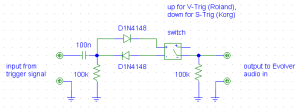I recently bought a Roland TR-77V, and after cleaning out the insect detritus and fixing the low conga sound (not working due to a poorly soldered inductor) and recording some other nonsense, I added this sync modification, appropriating the useless high impedance output jack as the sync input. It’s not a terribly robust modification, but it more or less does the job. It’s clocked by a falling edge trigger (S-Trig). The two S-Trig outputs on my Korg KPR-77, which correspond to the high and low tom sounds, can be used to either clock the TR-77 at a regular rate, or in some arbitrary programmable way. This sort of thing is frequently done with step sequencers, arpeggiators, etc. but not often with drum machines, where it can be used to make very complex rhythmic patterns. I’ve been exploring similar techniques in Pure Data, and will try to write more about this later.
I also thought it would be interesting to try to get the Dave Smith Instruments Evolver to respond to these triggers as well, so that it could be used in this MIDI-free setup. The Evolver’s sequencer has an audio trigger mode (EiC in the trigger select menu), but it doesn’t work well with these S-Trig or V-Trig signals (and feeding it the straight drum machine mix output can be a little erratic), so I thought I’d build a simple passive box to better interface them. Here’s the schematic (sorry the switch isn’t better looking).
It’s basically the same as a standard trigger circuit in an analog drum machine. The high pass RC network shapes the incoming pulse into a narrow impulse-like waveform, and the diode passes only the pulse’s rising edge (V-Trig) or falling edge (S-Trig) portion, according to the position of the switch. The resistor on the output side provides a discharge path, since the Evolver’s inputs by themselves are pretty high impedance.
The Evolver responds pretty well to this signal, and I tested it with both the KPR-77 and my Roland CR-8000. I can trigger steady 16th notes up to about 200 BPM. Latency is about 5 ms with +/- 0.3 ms jitter, which I think is fine. I’ve noticed as well that it seems perfectly acceptable, and maybe even desirable, for a bass or synth sound to be a little bit late compared to the drums. In examining my own sloppy playing, it’s far more objectionable for the synth to come even slightly before the drums, which I guess would be related to auditory masking. The CR-8000’s timing sucks anyway (and the KPR-77 may not be much better), so this is far from the weakest link in the chain. I prototyped and built this very quickly and didn’t rigorously tweak the component values; I just fiddled around until it was more or less acceptable, so it’s possible that this performance can be significantly improved.
So here’s the result of all that, with the KPR-77 triggering the TR-77 and the CR-8000 triggering the Evolver (and some pads from a Seiko DS-250):
So far this offers some interesting possibilities, but it’s still a bit basic. I think I can get more exciting things to happen if I add similar trigger inputs to other drum machines like the Korg KR-55B, and even auto-accompaniment keyboards like the Korg SAS-20.

Do you know if the Korg KPR-77 sends out flam from the trig out ?
It does.